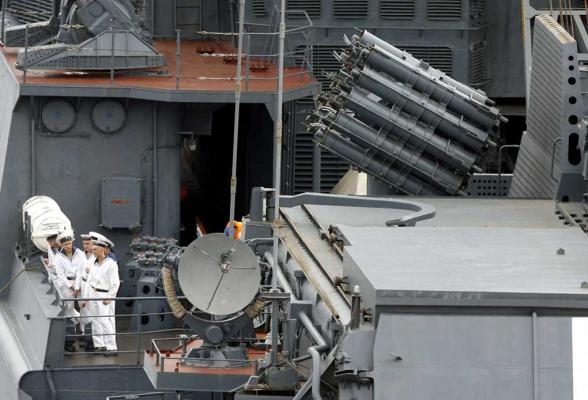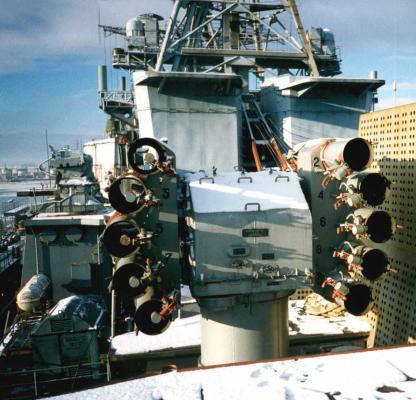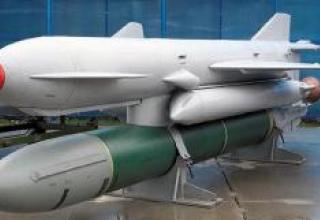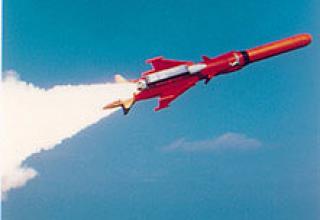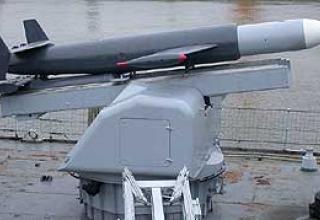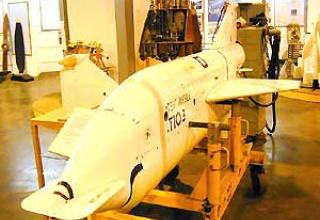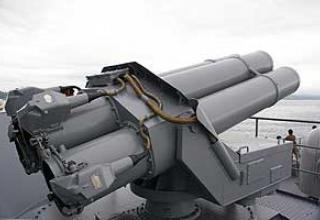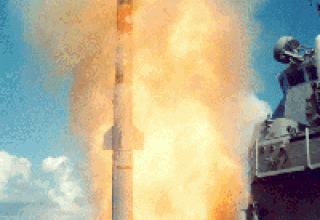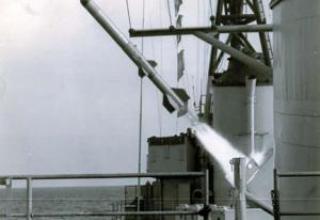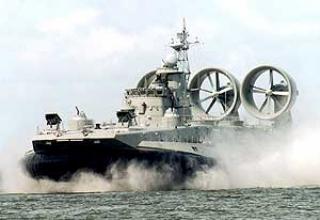The Udav-1M anti-torpedo protection jet complex (RKPTZ-1M) is designed to engage (retract) torpedoes attacking the ship. The complex can also be used to defeat submarines (including ultra-small ones), submarine sabotage forces and means.
The developer of the complex is Federal State Unitary Enterprise "State Research and Production Enterprise" Splav "(Tula). The enterprise R-6833 together with NITI and Research Institute "Search" were co-executers on the topics "Fire" and "Udav-1" in the development of detonating devices. The "Udav-1" anti-torpedo complex for the Navy was developed in accordance with the Decree of the USSR CM No.763-234 of October 15, 1971 and Order of the Minister of Mechanical Engineering No.430 of November 17, 1971. The complexes and weapon systems available in the Navy at that time did not provide effective protection of ships from attacking submarines and torpedoes in the near zone. Weapons for the last frontier of defense should have high firepower and maximum efficiency. The Udav-1 anti-torpedo protection system was the first of its kind in the world practice. The placement of the Udav-1 anti-torpedo protection complex was studied by the 956 and 962 project ships.
The "Udav-1" complex was developed as a part of three types of ammunition (projectile diverter, barrier projectile, deep projectile), ten-barreled automated launcher with tracking drives of guidance, firing control devices, charging and feeding devices. The Mesophilus is then developed to replace the depth projectile and the barrier as a single universal Mesophilus depth projectile or barrier, depending on the application. The upgraded complex was designated "Udav-1M" (RKPTZ-1M).
The "Udav-1" complex was adopted for service with the Navy in 1986 (Decree of the USSR CM dated 27.12.1986 N 1555-423), "Udav-1M" - in 2001. (Order of the SC of the Navy from 02.11.2001 N 491).
At present RKPTZ-1M is a part of armament: large anti-submarine ships of project 1155.1 ("Admiral Chabanenko"), heavy nuclear missile cruisers of project 1144 ("Peter the Great"), heavy aircraft carriers of project 11435 ("Admiral Kuznetsov") and others.
Composition:
The complex consists of:
- 300 mm rockets 111SO2 and 111SG;
- KT-153M launcher (see photo);
- delivery device 111UPM;
- the 111PM firing control device complex.
The implemented in the complex method of software automatic firing of rockets of various purposes provides creation of a highly effective echelonized system of ships' protection against attacking torpedoes. The peculiarity of the complex lies in the fact that in one salvo different types of rockets are launched at the range calculated for them. The first boundary of the defense is formed by two missiles, with the help of which four false targets are set. When a decoy target is captured, the torpedo leaves the attacking trajectory and moves towards decoy targets until its engine is completely shut down. When the first tier of the ship's defense is breached, the torpedo encounters a drifting minefield set by fence shells. The passage of the torpedo through the area affected by the fence projectile leads to its destruction. When the first and second echelons of the ship's defences are breached, the ship is hit by deep projectiles. One salvo of the "Udav-1M" complex with the probability of 0.9 ensures the failure of the attack of a straightforward torpedo and with the probability of 0.76 - of a self-guided torpedo.
A 300 mm rocketshell 111SO2 (see diagram). The diverter rocket is designed to divert the attacking torpedo from the ship, which has an acoustic homing system by setting two hydroacoustic false targets. The range of fire is from 700 to 3000m.
300mm Mesophilus 111SZG deep-detonation barrier projectile (see diagram). The 111SZG is used in both fence mode to create a drifting minefield curtain of several head units in the path of a torpedo, and depth bomb mode to engage torpedoes at a given depth, as well as submarines and saboteurs. The range of fire is from 100 to 2000m.
The KT-153M launcher is designed for guidance and provision of single and multiple rocket launches, as well as for storage of projectiles in the barrels during autonomous navigation of the ship. The number of guides - 10. Weight - 6200 kg.
The device of delivery of shells 111UPM in starting installation of the automated modular type with the conveyor is intended for automatic charging (discharging) of trunks of starting installation by jet shells, storage of shells in circles of the conveyor and their loading (unloading) from a deck of the ship in circles of the conveyor. Time of delivery of a projectile from the conveyor to the launcher (time of one cycle) 52-72s, quantity of projectiles in the conveyor - 21, 31 or 41 pieces.
The complex of 111PM firing control devices is designed to control the firing of reactive projectiles. The complex of firing control devices provides development of angles of guidance for the launcher, operation of the firing circuits of the complex. The firing control system works in conjunction with a hydroacoustic torpedo and submarine detection station.
Characteristics:
| Range of fire, m: - maximum - minimum |
3000 100 |
| Combat readiness of the complex from the moment of receiving data on the target, s | not more than 15 |
| Probability of hitting the submarine in one volley | up to 0.8 |
| Depth of engagement of the underwater target, m | up to 600 |
| Weight of the complex without ammunition, kg | 17800 |
| Probability of hitting the torpedo in one shot: - direct - self-directed |
0.9 0.76 |
| 300mm trapping projectile 111SO2 | |
| Caliber, mm | 300 |
| Length, mm | 2200 |
| Weight, kg | 201 |
| Number of false targets, pcs. | 2 |
| Range of fire, m: - maximum - minimum |
3000 700 |
| Temperature range of application, ° C | -40..+50 |
| 300mm deep-detonation barrier projectile 111SZG | |
| Caliber, mm | 300 |
| Length, mm | 2200 |
| Weight, kg | 230 |
| Weight of the explosive, kg | 80 |
| Range of fire, m: - maximum - minimum |
2000 100 |
| Temperature range of application, ° C | -40..+50 |
| Feeder 111 UPM | |
| Lifting height of shells, mm | 6100 - 14100 |
| Number of shells in the conveyor belt, pcs. | 21,31,41 |
| Maximum weight, kg | 6168 |
| Time of projectile feeding from conveyor belt to launcher, s | 52-72 |
Testing:
In 1990 Vladimir Dmitrievich Gerasimov was awarded the S.I. Mosin Prize for his work on the topic "For the development of the 111SO2 rocket projectile for the Udav-1M complex" (work presented by NPO SPLAV).
In 2017, the head of the department of JSC "NPO "SPLAV" Verbovenko Alexander Andreevich (head of work), chief engineer of JSC "Novosibirsk Artificial Fiber Factory" Viktor Vankov was awarded the S.I. Mosin Prize for work on the topic: "Creation of production and testing base for serial production of antithorpedic shell 111SZG". The work was presented to JSC "NPO SPLAV".
Sources:
- ГАУ ТО "ГА". Ф.Р-3428. Оп.1. Д.1194. ЛЛ.6,48,50.
- Люди, годы, залпы. 60 лет ФГУП “ГНПП “Сплав”/ ФГУП “ГНПП “Сплав”: составитель Е.М. Мартынов, под редакцией Н.А. Макаровца; ред коллегия: Г.А. Денежкин, Р.А. Кобылин, Г.И. Блинов. – Тула: ОАО “Тульская типография”, 2009.
- Премия имени С.И. Мосина: из века в век. – М.: Издательский дом «Оружие и технологии», 2018. – С. 190,193,206.
- ФГУП "Государственное научно-производственнон предприятие "СПЛАВ"
